The 12 Top Video Hosting Platforms in 2025 for Marketers



In 2025, selecting the right video hosting platform is a critical decision that directly impacts marketing performance, user engagement, and brand perception. Embedding a raw video file on your website leads to slow load times and a poor user experience, while simply using a public platform like YouTube can mean surrendering control over branding and sending valuable traffic to a competitor. The core problem these platforms solve is providing a reliable, fast, and feature-rich environment to store, manage, and deliver your video content effectively.
This guide dives deep into the top video hosting platforms in 2025, moving beyond surface-level feature lists to provide a comprehensive resource for marketers, founders, and creative directors. We'll analyze each platform's unique strengths and weaknesses to help you make an informed choice that aligns with your specific goals, whether you're a startup focused on lead generation or an enterprise requiring robust security and analytics.
Inside this resource, you will find:
- Detailed analyses of 12 leading platforms, including Vimeo, Wistia, Brightcove, and developer-focused options like Mux and Cloudflare Stream.
- Honest assessments of limitations and ideal use cases.
- Practical implementation insights to get you started quickly.
- Direct links and screenshots for every platform reviewed.
Our goal is to cut through the marketing jargon and equip you with the practical knowledge needed to select a platform that not only hosts your videos but also enhances your marketing strategy and drives measurable results. Let's find the perfect fit for your business.
1. YouTube
YouTube remains an essential, if not mandatory, platform for any brand looking to maximize audience reach and leverage the power of search. As the world's second-largest search engine, it stands out as one of the top video hosting platforms in 2025 primarily for its unparalleled discovery potential. It is completely free for hosting unlimited videos, making it an accessible starting point for businesses of all sizes.
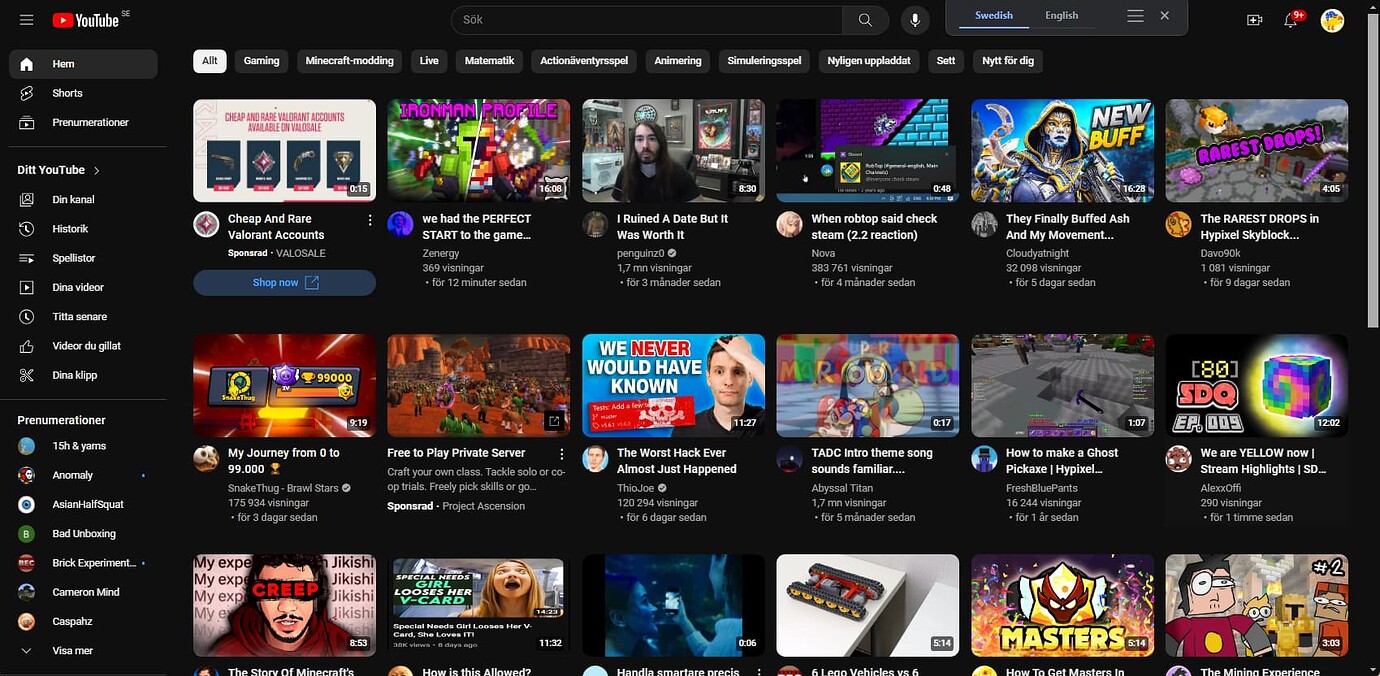
While many platforms offer hosting, YouTube offers a built-in audience. Its algorithm actively promotes content to relevant viewers, creating a powerful engine for organic growth. Marketers can use it for public-facing content like tutorials, brand stories, and product launches, leveraging its robust analytics to track viewer engagement and demographics. To fully capitalize on this, mastering the platform's SEO is a key part of any successful digital video marketing strategy.
Use Case & Implementation
YouTube is ideal for top-of-funnel marketing activities where brand awareness and community building are the primary goals.
- Best For: Public brand channels, educational content, tutorials, and building a subscriber community.
- Pricing: Free, with monetization available through the YouTube Partner Program.
- Key Features: Public, unlisted, and private videos; live streaming; Shorts (for short-form content); and detailed channel analytics.
- Implementation Tip: Use "unlisted" visibility for embedding videos on your website if you want to bypass ads without paying for a premium service, but be aware you lose all branding control over the player.
Pros & Cons
Website: https://www.youtube.com
2. Vimeo
Vimeo positions itself as the professional-grade alternative to YouTube, making it one of the top video hosting platforms in 2025 for businesses that prioritize branding and control. Where YouTube focuses on discovery, Vimeo excels at providing a clean, ad-free environment for showcasing high-quality content. It’s built for creators and companies who need their videos to look polished and professional wherever they are embedded, without external distractions.
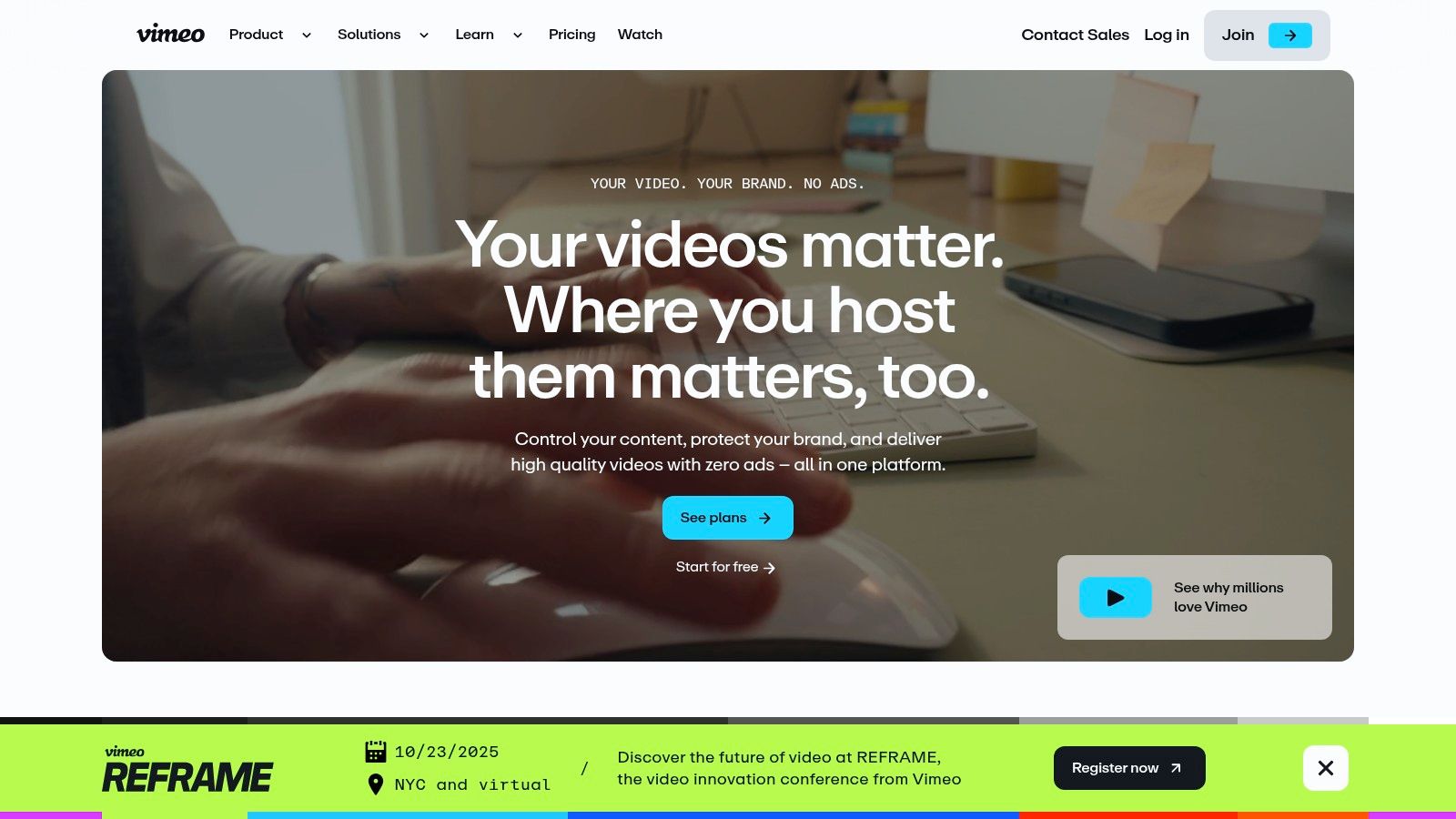
The platform’s strength lies in its powerful, customizable player and robust privacy settings. Marketers can change player colors, add their own logos, and control exactly where their videos can be viewed using domain-level privacy. Higher-tier plans expand its utility into a full-suite video marketing tool, offering advanced analytics, lead capture forms within the player, and team collaboration features. The recent addition of AI tools like a teleprompter and text-based editing further streamlines the content creation workflow.
Use Case & Implementation
Vimeo is the go-to platform for mid-to-bottom-of-funnel content where presentation and user experience are critical.
- Best For: Hosting on-site marketing videos, course content, internal training, and corporate communications.
- Pricing: Starts with a limited free plan; paid plans offer more storage, features, and seats, scaling up significantly for enterprise needs.
- Key Features: Ad-free customizable player; advanced privacy controls; lead generation tools; detailed analytics; and team collaboration seats.
- Implementation Tip: Use the advanced analytics to track engagement on your sales pages. You can see which parts of a product demo are re-watched most often, providing valuable insight into customer interest.
Pros & Cons
Website: https://vimeo.com
3. Wistia
Wistia is built from the ground up for marketers who need their videos to do more than just sit on a page. It distinguishes itself by focusing on lead generation and conversion, making it one of the top video hosting platforms in 2025 for businesses aiming to turn viewers into customers. Instead of prioritizing public discovery, Wistia provides tools to integrate video seamlessly into your marketing funnel with a fully brandable player and powerful analytics.
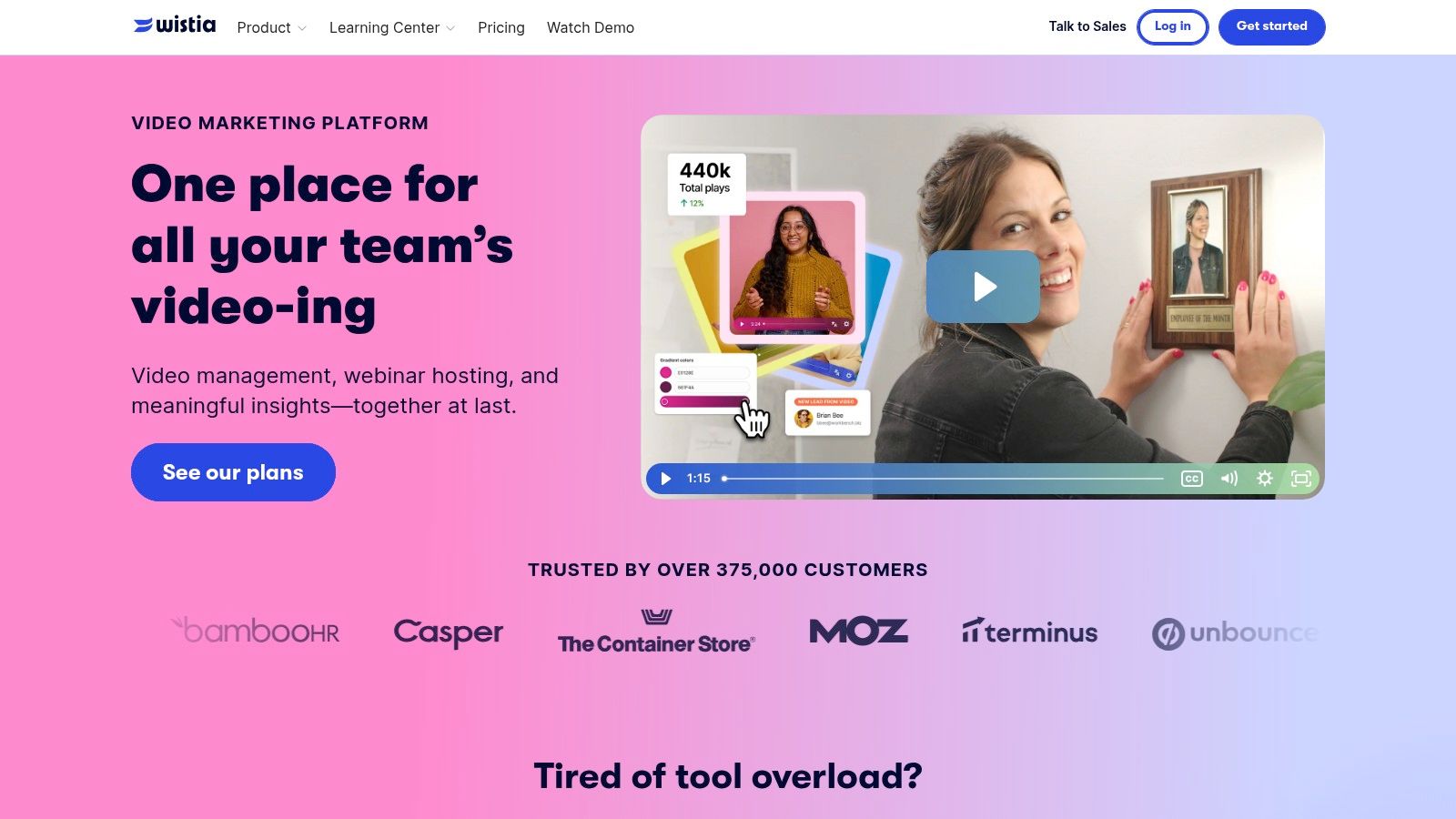
The platform shines with its in-player lead capture forms (Turnstiles), clickable calls-to-action, and deep integrations with CRM and marketing automation tools like HubSpot and Salesforce. This allows marketers to track not just views, but how individual videos influence the customer journey. Its detailed heatmaps show exactly which parts of a video viewers are watching, re-watching, or skipping, providing invaluable feedback for content optimization. For those looking to maximize on-site engagement, creating dedicated video landing pages with Wistia’s embeddable player is a highly effective strategy.
Use Case & Implementation
Wistia is ideal for middle and bottom-of-the-funnel marketing where video is used to educate, nurture, and convert leads.
- Best For: B2B marketing, sales enablement, product demos, and online courses.
- Pricing: Starts with a free plan. Paid plans are based on video count, bandwidth, and features, scaling with usage.
- Key Features: Customizable player, lead capture forms, in-player CTAs, video heatmaps, A/B testing, and CRM integrations.
- Implementation Tip: Use Wistia Channels to create branded, binge-worthy video galleries on your website, perfect for housing a webinar library or a product tutorial series.
Pros & Cons
Website: https://wistia.com
4. Brightcove
Brightcove is an enterprise-grade video cloud platform designed for large-scale publishers, broadcasters, and global brands requiring maximum reliability and security. It distinguishes itself from simpler hosting tools by focusing on comprehensive monetization and broadcast-quality streaming. As one of the top video hosting platforms in 2025, its strength lies in providing a robust, scalable infrastructure for delivering live and on-demand video with advanced digital rights management (DRM).
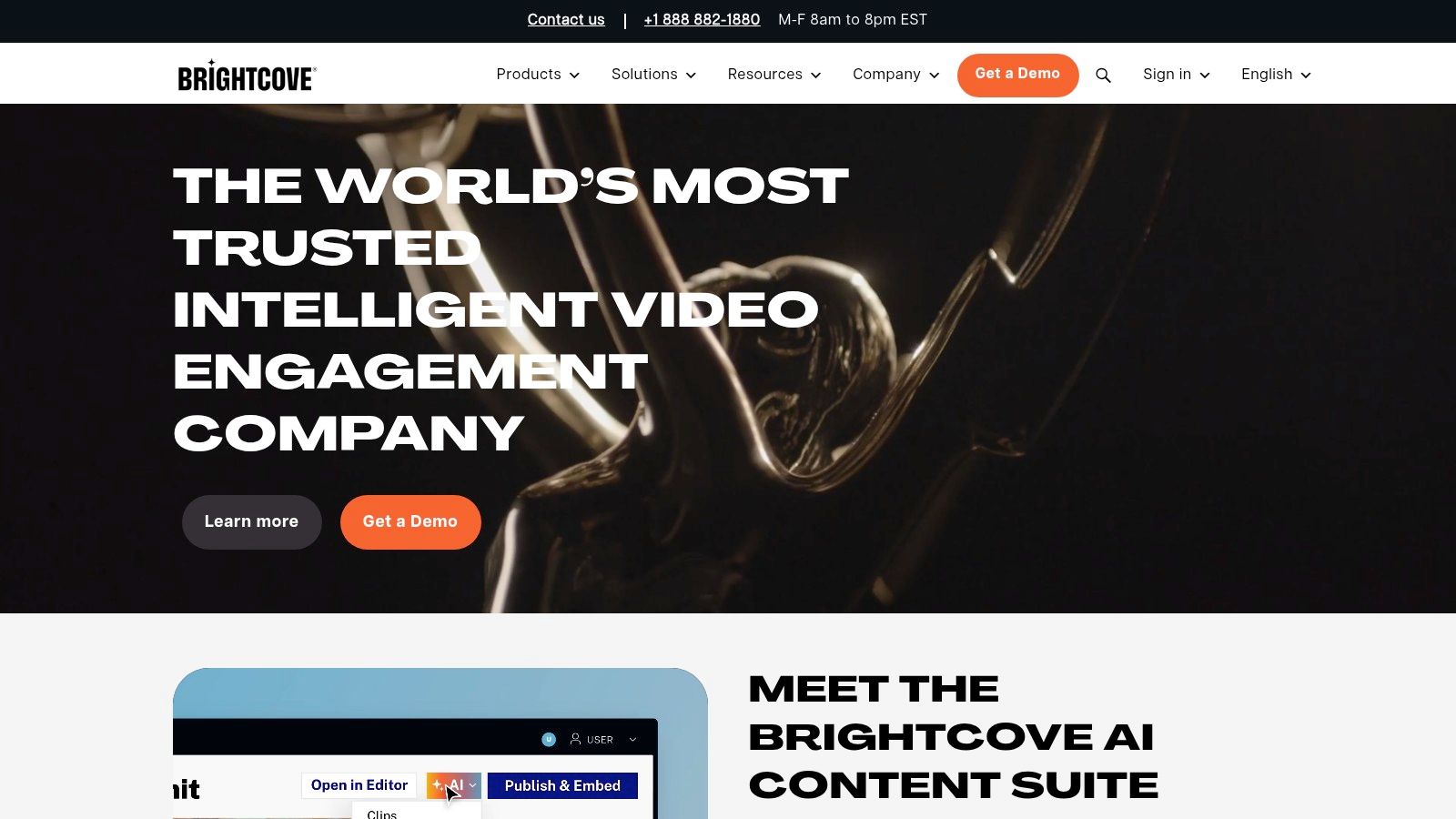
The platform is built for complex video workflows, offering flexible monetization models including ad-supported (AVOD), subscription-based (SVOD), and transactional (TVOD) options. Its server-side ad insertion technology provides a seamless, TV-like viewing experience, bypassing ad blockers. For enterprises managing vast libraries, Brightcove’s powerful APIs and integrations are essential for connecting video to other business systems, making it a cornerstone for sophisticated creative asset management.
Use Case & Implementation
Brightcove excels in scenarios where video is a core revenue driver and security is non-negotiable, such as OTT services and corporate communications.
- Best For: Broadcasters, large media companies, and enterprises needing secure, high-quality live and VOD streaming.
- Pricing: Custom quote-based pricing; plans are tailored to usage and feature requirements.
- Key Features: Enterprise-grade DRM and security, server-side ad insertion (SSAI), detailed audience analytics, and OTT/FAST channel creation.
- Implementation Tip: Leverage Brightcove's extensive API library to integrate the video player directly into your existing content management system (CMS) and marketing automation platforms for a seamless workflow.
Pros & Cons
Website: https://www.brightcove.com
5. JWP (JW Player / JWP Connatix)
Following its 2024 merger with Connatix, JWP has solidified its position as a powerhouse for publishers and broadcasters. It's built around a famously fast and reliable HTML5 video player, providing the core infrastructure for high-volume streaming, advanced monetization, and audience engagement. This makes it one of the top video hosting platforms in 2025 for media companies that require a robust, scalable, and ad-centric video ecosystem.
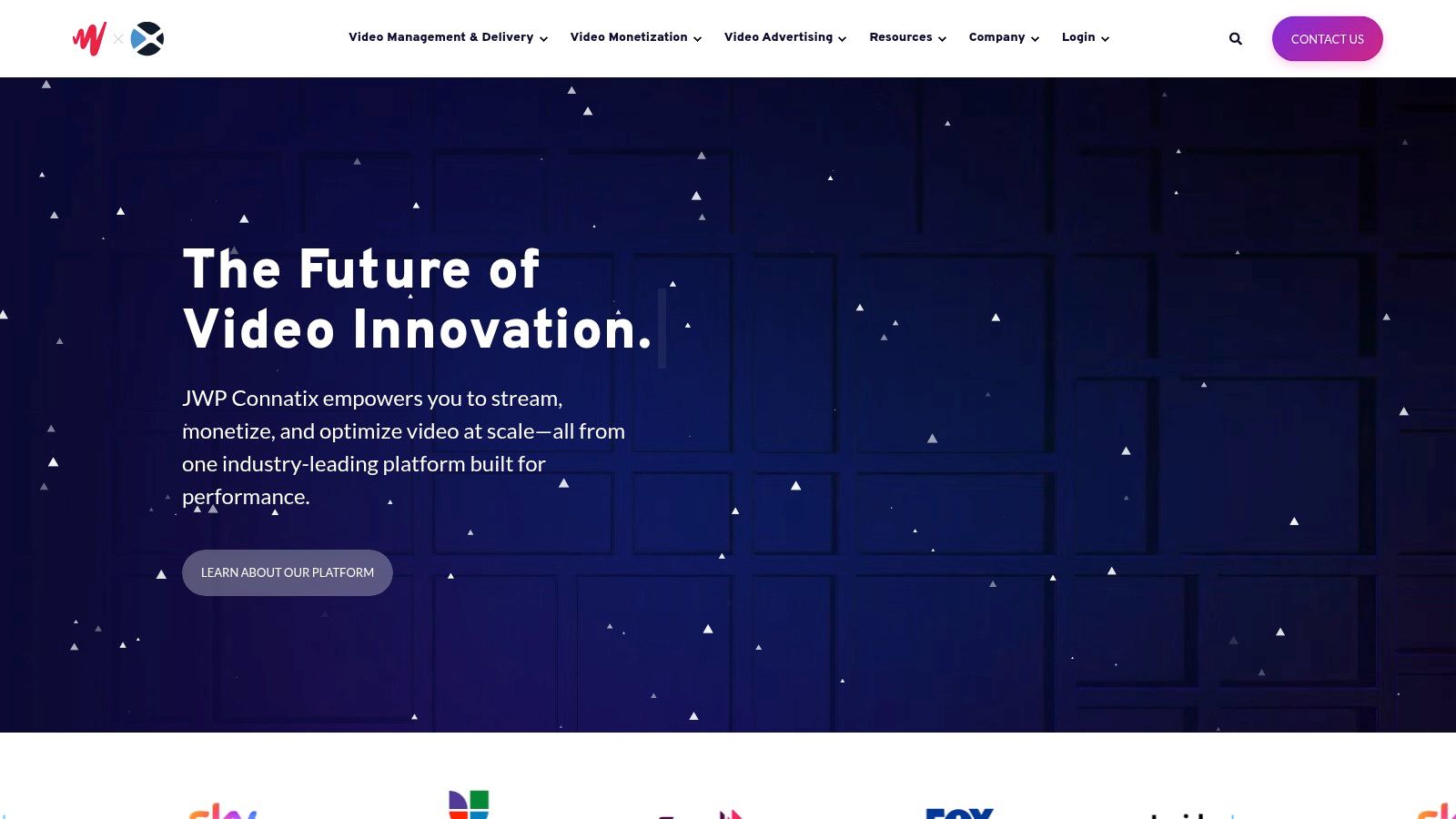
Unlike platforms geared toward individual creators or marketers, JWP's strength lies in its publisher-focused toolkit. It offers sophisticated programmatic advertising capabilities, server-side ad insertion (SSAI) to bypass ad blockers, and powerful recommendation engines to increase viewer session times. This enterprise-grade focus means it's designed for technical teams looking to integrate a high-performance video solution directly into their own properties, including OTT apps.
Use Case & Implementation
JWP is the go-to choice for large-scale media publishers whose business model relies heavily on video advertising revenue and audience retention across their own websites and apps.
- Best For: Media publishers, broadcasters, and enterprises needing advanced ad monetization and OTT solutions.
- Pricing: Custom enterprise pricing only; you must contact their sales team for a quote.
- Key Features: High-performance HTML5 player, live and instant-live streaming, mobile SDKs, server-side ad insertion (SSAI), and advanced analytics.
- Implementation Tip: Leverage JWP's recommendation engine API to build custom content discovery experiences on your site, which can significantly lift user engagement and ad impressions.
Pros & Cons
Website: https://www.jwplayer.com
6. Vidyard
Vidyard is a powerful video platform designed specifically for sales and marketing teams, shifting the focus from broad public hosting to personalized, one-to-one communication. Where other platforms focus on reach, Vidyard excels at engagement and conversion within the business pipeline. It stands out among the top video hosting platforms in 2025 for its deep integration with CRMs and marketing automation tools, turning video into a measurable sales asset.
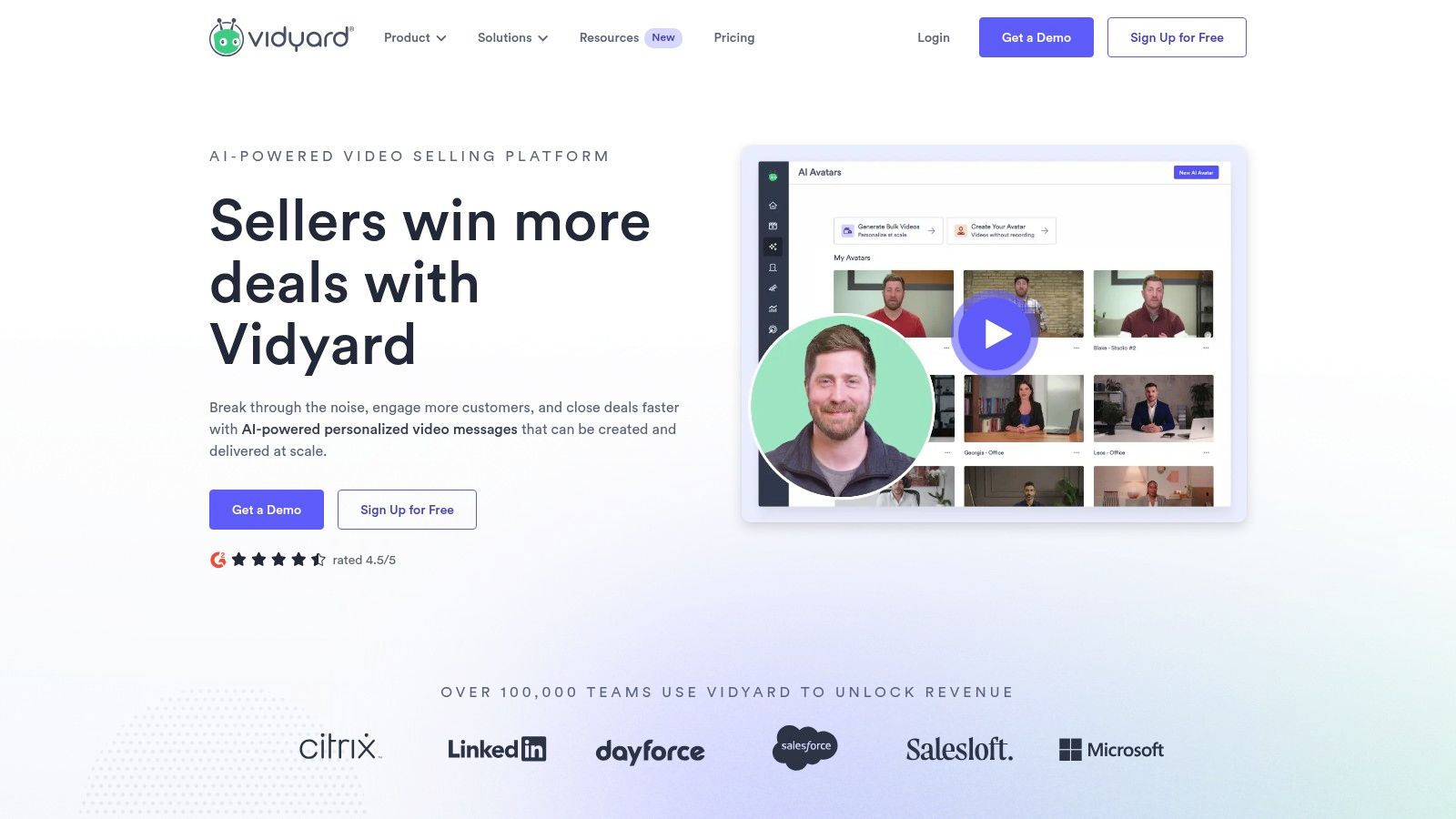
The platform empowers teams to quickly record and share personalized screen recordings and webcam videos, complete with branded landing pages and clear calls-to-action. Its analytics provide granular insights into who is watching your videos and for how long, feeding this data directly into your sales and marketing systems. This makes it an indispensable tool for everything from prospecting and outreach to creating compelling product demo videos.
Use Case & Implementation
Vidyard is ideal for high-touch sales, marketing, and customer success workflows where personalization drives results.
- Best For: Sales prospecting, account-based marketing, personalized product demos, and internal corporate communications.
- Pricing: Offers a free plan for individuals. Paid plans start at $29/user/month and scale with additional features and team members.
- Key Features: Screen and webcam recording, AI script and avatar generation, customizable video landing pages, in-video CTAs, and detailed viewer analytics.
- Implementation Tip: Integrate Vidyard directly with your CRM (like Salesforce or HubSpot) to automatically log video engagement on contact records, giving your sales team real-time visibility into a prospect's interest level.
Pros & Cons
Website: https://www.vidyard.com
7. Kaltura
Kaltura carves out a unique space in the market as a highly flexible, open-source video platform built for large institutions. Its strength lies in its modular, API-first architecture, making it one of the top video hosting platforms in 2025 for organizations in education, enterprise, and media that require deep customization and integration. Unlike turnkey solutions, Kaltura provides a framework to build bespoke video experiences, from secure internal training portals to full-scale OTT services.

This platform excels in environments where video must integrate seamlessly with existing systems like Learning Management Systems (LMS) or Single Sign-On (SSO) for authentication. Its robust suite includes a Video Content Management System (VCMS), virtual classrooms, and tools for interactive video, all supported by powerful APIs. This allows developers to create custom workflows and ensure video content is a core part of their digital ecosystem, rather than just an add-on. For a deeper understanding of how integrated video can drive results, you can learn more about using video for lead generation on moonb.io.
Use Case & Implementation
Kaltura is best suited for large-scale, complex video needs where control and integration are paramount, particularly in education and corporate settings.
- Best For: Universities, large corporations, and media companies needing a customized and secure video infrastructure.
- Pricing: Primarily custom quotes based on usage and required modules, catering to enterprise budgets.
- Key Features: Extensive APIs and SDKs, strong LMS and SSO integrations, granular access control, interactive video tools, and advanced accessibility features.
- Implementation Tip: Plan for dedicated technical resources or administrative support. The platform's power comes from its flexibility, which requires a steeper learning curve to fully leverage.
Pros & Cons
Website: https://corp.kaltura.com
8. Panopto
Panopto has carved out an indispensable niche as a leading video platform for the education and enterprise sectors. It is one of the top video hosting platforms in 2025 because it excels at secure, searchable internal video management, particularly for lecture capture and corporate training. It is not a marketing tool but a powerful knowledge repository, designed to make vast video libraries accessible and engaging for internal audiences.
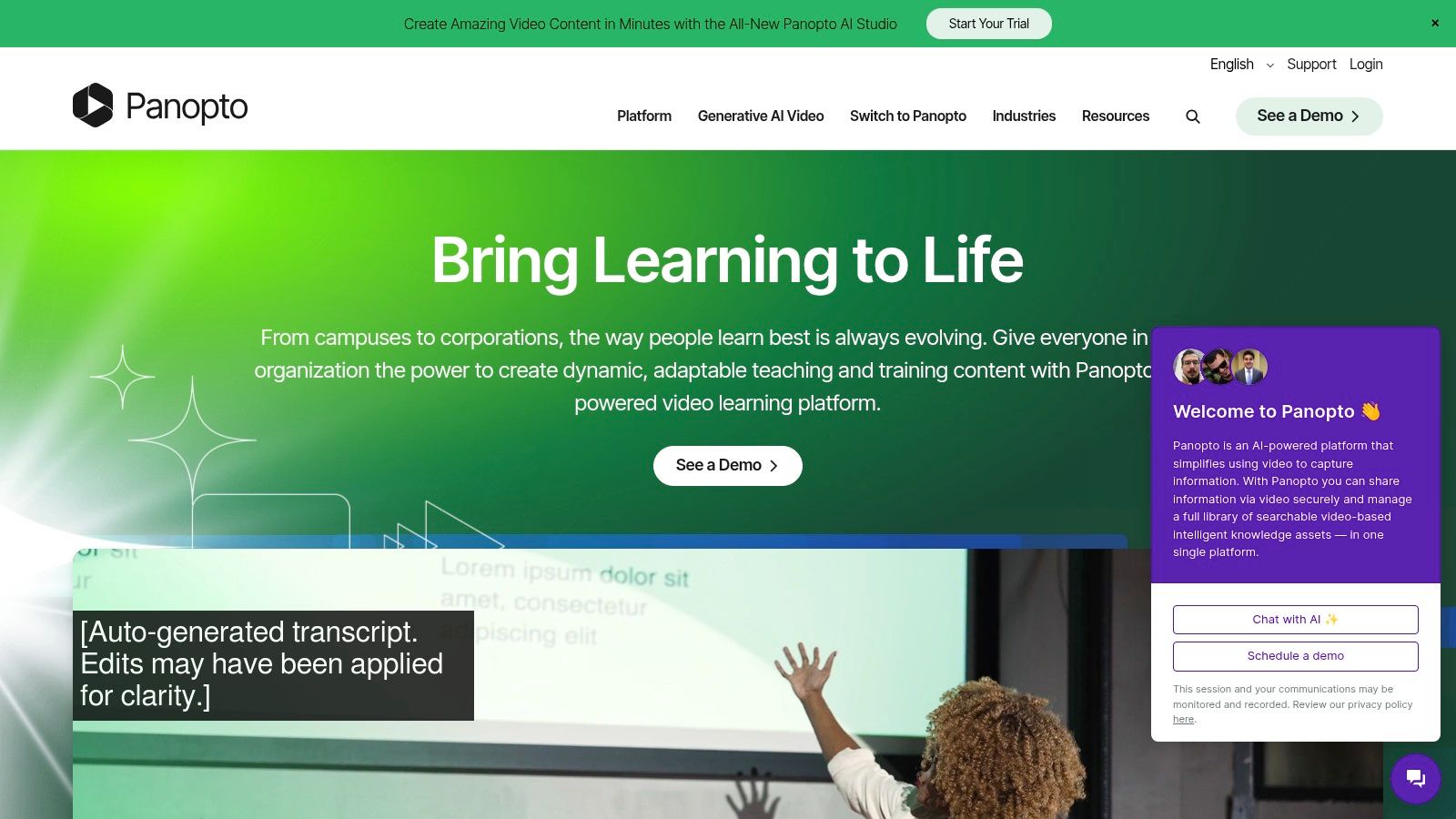
The platform’s core strength lies in its "inside video" search, which uses automatic speech recognition (ASR) and optical character recognition (OCR) to index every word spoken or shown on screen. This allows users to find exact moments in long recordings, transforming passive video archives into active learning resources. Its deep integrations with Learning Management Systems (LMS) and video conferencing tools like Zoom and Microsoft Teams make it a seamless part of the institutional tech stack.
Use Case & Implementation
Panopto is the go-to solution for large organizations that need to capture, manage, and deliver educational or training video content securely at scale.
- Best For: University lecture capture, corporate training, internal communications, and creating secure video knowledge bases.
- Pricing: Contract-based, typically licensed per user or FTE (full-time equivalent) for institutions.
- Key Features: Inside-video search (ASR/OCR), multi-stream recording, interactive quizzing, robust LMS and SSO integrations, and detailed viewer analytics.
- Implementation Tip: Leverage the platform’s automated recording and publishing workflows from Zoom or Teams to build your video library with minimal administrative effort.
Pros & Cons
Website: https://www.panopto.com
9. SproutVideo
SproutVideo secures its position as one of the top video hosting platforms in 2025 by offering a powerful yet accessible suite of tools tailored for small to mid-sized businesses. It masterfully blends marketing automation, robust security, and detailed analytics into a single, user-friendly package. The platform is designed for businesses that need more brand control and lead generation capabilities than YouTube offers, without the enterprise-level complexity or cost of other premium hosts.
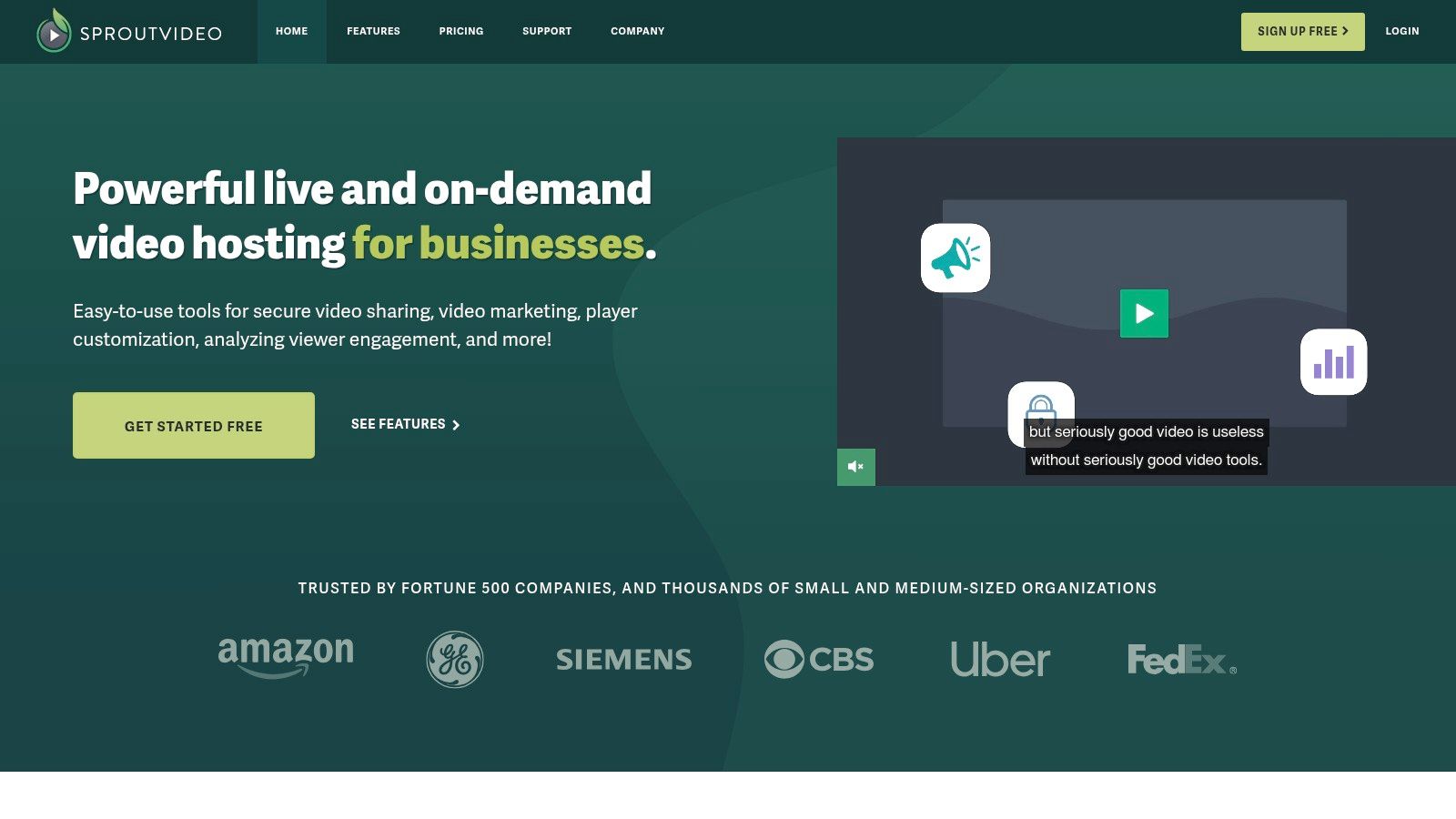
What makes SproutVideo stand out is its emphasis on creating fully branded viewing experiences. Users can build and customize everything from the video player to complete video websites and secure portals, all without writing a line of code. This makes it an excellent choice for delivering training content, hosting marketing videos, or creating internal video hubs with features like login protection and signed embeds for enhanced security.
Use Case & Implementation
SproutVideo is ideal for marketers and businesses who need a secure, brandable, and lead-generation-focused video solution.
- Best For: Gated marketing content, internal corporate training, lead generation, and creating branded video portfolios.
- Pricing: Starts with a 14-day free trial. Paid plans are transparent and based on storage, bandwidth, and features, beginning around $10/month.
- Key Features: Customizable white-label player, lead capture forms, post-play CTAs, detailed engagement analytics, and secure video portals with password protection.
- Implementation Tip: Use the "Video Site" feature to quickly launch a branded microsite for a specific campaign or product launch, embedding your lead capture forms directly to sync with your CRM.
Pros & Cons
Website: https://sproutvideo.com
10. Cloudflare Stream
Cloudflare Stream offers a developer-first approach to video, providing a powerful, API-driven hosting and streaming service built on its world-renowned global network. It is a standout choice among the top video hosting platforms in 2025 for businesses that need scalable infrastructure without complex overhead. Its primary advantage is a simple, predictable pricing model where you only pay for video minutes stored and delivered, with encoding and ingress being completely free.

This platform is not for marketers looking for a drag-and-drop solution; instead, it empowers developers to build custom video experiences directly into applications, websites, and SaaS products. By leveraging Cloudflare’s massive CDN and security infrastructure, it ensures fast, reliable delivery worldwide. This integrated approach often proves more cost-effective and operationally simpler than piecing together separate cloud services for encoding, storage, and delivery.
Use Case & Implementation
Cloudflare Stream is perfectly suited for integrating high-quality video into applications or platforms where performance, security, and predictable costs are paramount.
- Best For: SaaS platforms, e-learning sites, corporate training portals, and any application requiring a custom, integrated video player.
- Pricing: Usage-based. Storage is $5 per 1,000 minutes per month; delivery is $1 per 1,000 minutes viewed. No egress fees.
- Key Features: Unified API for VOD and live streaming, developer-friendly tools like signed URLs and webhooks, and built-in delivery optimization via Cloudflare's CDN.
- Implementation Tip: Use signed URLs to protect your premium content, allowing you to generate time-limited, private links for specific users, preventing unauthorized sharing and embedding.
Pros & Cons
Website: https://www.cloudflare.com/products/cloudflare-stream
11. Mux
Mux is a developer-first, API-centric platform designed for businesses that need to build custom, scalable video experiences directly into their products. Unlike out-of-the-box solutions, Mux provides the underlying infrastructure for both video-on-demand and live streaming, making it one of the top video hosting platforms in 2025 for SaaS, e-learning, and marketplace applications. Its strength lies in giving developers granular control over the entire video pipeline, from ingestion to delivery and analytics.
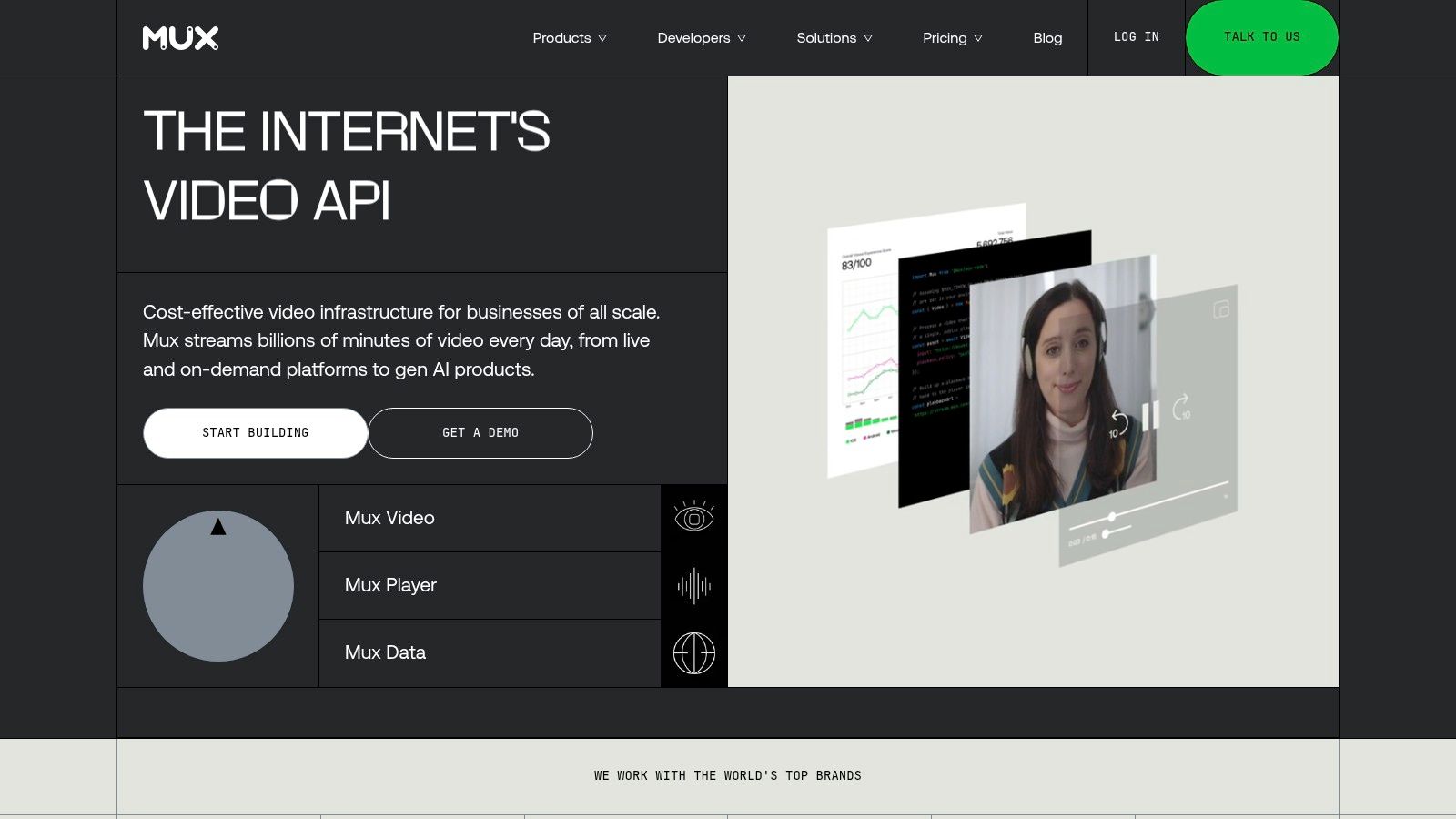
The platform is engineered for performance and reliability, using a multi-CDN approach to ensure optimal playback quality globally. Mux stands out for its transparent, usage-based pricing model, which has recently become even more attractive with built-in discounts for cold storage and a generous free tier. This makes it an economically sound choice for startups and enterprises alike who prioritize a high-quality, deeply integrated user experience over a simple embeddable player.
Use Case & Implementation
Mux is the ideal solution for engineering teams building video-centric features where a seamless, branded experience is non-negotiable.
- Best For: SaaS platforms, OTT services, e-learning portals, and marketplaces requiring custom video integration.
- Pricing: Minutes-based with a free tier (100K delivery minutes/month) and automatic discounts up to 60% for cold storage.
- Key Features: VOD up to 4K and live streams up to 1080p, powerful player SDKs, real-time quality-of-experience analytics, and developer-friendly APIs.
- Implementation Tip: Leverage Mux's extensive documentation and SDKs to get started quickly. Plan your data architecture to take full advantage of automatic cold storage discounts for less-frequently accessed content.
Pros & Cons
Website: https://www.mux.com
12. Bunny.net Stream
Bunny.net Stream enters the market as a disruptor, offering a high-performance, developer-friendly solution at a fraction of the cost of its competitors. Its core strength lies in its pay-as-you-go pricing model, which charges only for CDN traffic and storage, making it one of the top video hosting platforms in 2025 for budget-conscious businesses. This approach eliminates complex plans and transcoding fees, providing a transparent and highly scalable service.

The platform is built on Bunny.net's powerful global CDN, ensuring fast load times and smooth playback, especially for audiences in the US and Europe. While it lacks the advanced marketing integrations of a platform like Wistia, it excels at its primary function: reliable, cost-effective video delivery. It's a pragmatic choice for websites, e-learning platforms, and applications where performance and cost are more critical than lead-generation tools.
Use Case & Implementation
Bunny.net Stream is perfect for integrating video directly into websites, apps, or online courses without breaking the bank.
- Best For: E-learning platforms, membership sites, and businesses needing affordable global video delivery.
- Pricing: Pure pay-as-you-go for storage and bandwidth, with a low $1 minimum monthly charge. No transcoding fees.
- Key Features: Global CDN, free embedded player, distributed storage, and the ability to enable/disable specific geographic regions to control costs.
- Implementation Tip: Use the built-in player for simplicity, but for more advanced features like custom skins or analytics, you can easily integrate a third-party player like Plyr.io with the Bunny.net stream URL.
Pros & Cons
Website: https://bunny.net/stream
Top 12 Video Hosting Platforms Comparison
Final Thoughts
Navigating the landscape of the Top Video Hosting Platforms in 2025 can feel overwhelming, but it boils down to a single, critical principle: aligning the platform's core strengths with your specific business objectives. As we've explored, the "best" platform isn't a one-size-fits-all solution. Instead, it’s a strategic choice that can either accelerate your growth or become a bottleneck to your marketing and communication efforts.
The journey from a free, general-purpose platform like YouTube to a sophisticated, enterprise-grade solution like Brightcove or Kaltura is a testament to the evolution of video itself. It has transformed from a simple content format into a powerful engine for lead generation, customer engagement, internal training, and even direct monetization. Your choice of host directly impacts your ability to harness this power effectively.
Key Takeaways for Making Your Decision
Reflecting on our deep dive into the top contenders, several core themes emerge. Remember these as you move toward a final decision:
- Audience vs. Analytics: Platforms like YouTube and Vimeo offer massive built-in audiences, which is invaluable for top-of-funnel awareness. However, specialized B2B hosts like Wistia, Vidyard, and SproutVideo provide granular analytics and marketing automation integrations that are essential for converting viewers into qualified leads.
- Developer-First vs. Marketer-First: The rise of API-driven platforms like Mux, Cloudflare Stream, and Bunny.net Stream highlights a major trend. These tools offer unparalleled flexibility and cost-effectiveness for teams with development resources, allowing you to build a completely custom video infrastructure. This contrasts with the marketer-first, all-in-one solutions that prioritize ease of use and out-of-the-box features.
- Scalability is a Spectrum: For startups, a platform like SproutVideo or even Vimeo's paid tiers offers an affordable, feature-rich starting point. As you scale, your needs may evolve toward the robust security and live-streaming capabilities of a platform like JWP or the extensive internal knowledge management features of Panopto. Plan for where you want to be in two years, not just where you are today.
Your Actionable Next Steps
Making the right choice requires methodical evaluation, not just a gut feeling. Here’s a simple framework to guide your next steps:
- Define Your Primary Use Case: Be brutally honest. Is your main goal lead generation, brand awareness, internal training, or powering a video-centric product? Your primary goal will immediately eliminate several options.
- Audit Your Technical Resources: Do you have a developer who can work with APIs, or do you need a drag-and-drop interface that a marketing manager can operate independently? This is a crucial fork in the road between platforms like Mux and Wistia.
- Map Your Existing Tech Stack: List the essential tools you already use, such as your CRM (HubSpot, Salesforce), marketing automation platform, and analytics tools. Check for native integrations to ensure a seamless flow of data.
- Initiate Free Trials: Shortlist your top 2-3 candidates and commit to using their free trials. Don't just browse the dashboard. Upload a few real videos, embed them on a test page, and explore the analytics. This hands-on experience is non-negotiable.
Choosing from the Top Video Hosting Platforms in 2025 is more than a technical decision; it's a strategic investment in your brand's future. The right platform will not only house your content but will also unlock new ways to connect with your audience, analyze performance, and drive measurable business results. The perfect fit is out there, waiting to help you turn your video vision into a reality.
Once you've chosen your hosting platform, the challenge shifts to producing a steady stream of high-quality video content. Moonb offers an on-demand video editing service that integrates seamlessly with your workflow, providing fast turnarounds on everything from social clips to polished corporate videos. Scale your video production effortlessly with a dedicated team by visiting Moonb to see how we can help you keep your new video platform filled with engaging content.






